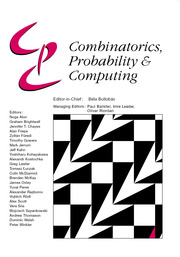No CrossRef data available.
Article contents
Common pairs of graphs
Published online by Cambridge University Press: 30 June 2025
Abstract
A graph  $H$ is said to be common if the number of monochromatic labelled copies of
$H$ is said to be common if the number of monochromatic labelled copies of  $H$ in a red/blue edge colouring of a large complete graph is asymptotically minimised by a random colouring in which each edge is equally likely to be red or blue. We extend this notion to an off-diagonal setting. That is, we define a pair
$H$ in a red/blue edge colouring of a large complete graph is asymptotically minimised by a random colouring in which each edge is equally likely to be red or blue. We extend this notion to an off-diagonal setting. That is, we define a pair  $(H_1,H_2)$ of graphs to be
$(H_1,H_2)$ of graphs to be  $(p,1-p)$-common if a particular linear combination of the density of
$(p,1-p)$-common if a particular linear combination of the density of  $H_1$ in red and
$H_1$ in red and  $H_2$ in blue is asymptotically minimised by a random colouring in which each edge is coloured red with probability
$H_2$ in blue is asymptotically minimised by a random colouring in which each edge is coloured red with probability  $p$ and blue with probability
$p$ and blue with probability  $1-p$. Our results include off-diagonal extensions of several standard theorems on common graphs and novel results for common pairs of graphs with no natural analogue in the classical setting.
$1-p$. Our results include off-diagonal extensions of several standard theorems on common graphs and novel results for common pairs of graphs with no natural analogue in the classical setting.
Keywords
Information
- Type
- Paper
- Information
- Copyright
- © The Author(s), 2025. Published by Cambridge University Press


